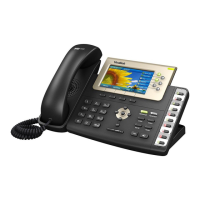Product Overview
1
This chapter contains the following information about the SIP-T3xG IP phones:
VoIP Principle
SIP Components
SIP IP Phone Models
VoIP
VoIP (Voice over Internet Protocol) is a technology using the Internet Protocol instead of
traditional Public Switch Telephone Network (PSTN) technology for voice
communications.
It is a family of technologies, methodologies, communication protocols, and
transmission techniques for the delivery of voice communications and multimedia
sessions over IP networks. The H.323 and Session Initiation Protocol (SIP) are two
popular VoIP protocols that are found in widespread implement.
H.323
H.323 is a recommendation from the ITU Telecommunication Standardization Sector
(ITU-T) that defines the protocols to provide audio-visual communication sessions on
any packet network. The H.323 standard addresses call signaling and control,
multimedia transport and control, and bandwidth control for point-to-point and
multi-point conferences.
It is widely implemented by voice and video conference equipment manufacturers, is
used within various Internet real-time applications such as GnuGK and NetMeeting and
is widely deployed worldwide by service providers and enterprises for both voice and
video services over IP networks.
SIP
SIP (Session Initiation Protocol) is the Internet Engineering Task Force’s (IETF’s) standard
for multimedia conferencing over IP. It is an ASCII-based, application-layer control
protocol (defined in RFC 3261) that can be used to establish, maintain, and terminate
calls between two or more endpoints. Like other VoIP protocols, SIP is designed to
address the functions of signaling and session management within a packet telephony
network. Signaling allows call information to be carried across network boundaries.
Session management provides the ability to control the attributes of an end-to-end call.

